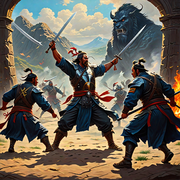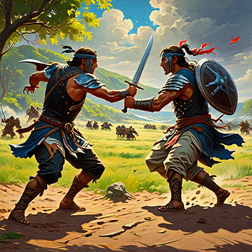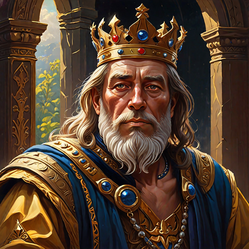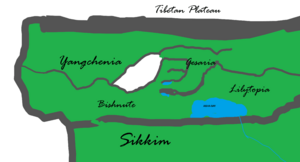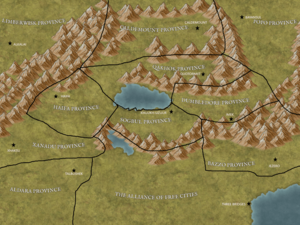Gesaria: Difference between revisions
| Line 383: | Line 383: | ||
Gesarian Buddhism is similar to Buddhism, it is based on the principles of achieving happiness and satisfaction in life. Gesarian Buddhists believe that life is all about finding happiness within oneself, and that involves removing materialistic desires from oneself, and instead pursue what makes you happy, what gives you peace, and what gives you wisdom and enlightenment. Material things can be destroyed or stolen by others, while no one in the world can steal your wisdom and enlightenment, it is something that is inherently yours. Gesarian Buddhism also teaches that letting people disrupt your state of peace of mind can lead to unhappiness and you should stay away from such people as they are "negatives" in your life that dont interact with you well. | Gesarian Buddhism is similar to Buddhism, it is based on the principles of achieving happiness and satisfaction in life. Gesarian Buddhists believe that life is all about finding happiness within oneself, and that involves removing materialistic desires from oneself, and instead pursue what makes you happy, what gives you peace, and what gives you wisdom and enlightenment. Material things can be destroyed or stolen by others, while no one in the world can steal your wisdom and enlightenment, it is something that is inherently yours. Gesarian Buddhism also teaches that letting people disrupt your state of peace of mind can lead to unhappiness and you should stay away from such people as they are "negatives" in your life that dont interact with you well. | ||
Gesarian Buddhism uniquely teaches about the concept of a '''ruling deity,''' a sort of God-like figure that watches over you and other people that were born under that deity. They are called '''Domains,''' and there are 4 domains, '''Domain of Yangchen, Domain of Bishnu, Domain of Gesar, and Domain of Ram.''' These domains are also paired with a respective elemental Dragon, '''Fire Dragon(Yangchen), Earth Dragon(Bishnu), Ice Dragon(Gesar), and Thunder Dragon(Ram).''' Your domain is decided by your birth year, and which deity and dragon rules over that year. This belief in Domains and Dragons has a unique term, ('''Qik)''' meaning natural self. The qualities associated with each domain is your natural self, and instead of trying to be someone else, you should just be yourself. You are your natural you, and you should stick with it | Gesarian Buddhism uniquely teaches about the concept of a '''ruling deity,''' a sort of God-like figure that watches over you and other people that were born under that deity. They are called '''Domains,''' and there are 4 domains, '''Domain of Yangchen, Domain of Bishnu, Domain of Gesar, and Domain of Ram.''' These domains are also paired with a respective elemental Dragon, '''Fire Dragon(Yangchen), Earth Dragon(Bishnu), Ice Dragon(Gesar), and Thunder Dragon(Ram).''' Your domain is decided by your birth year, and which deity and dragon rules over that year. This belief in Domains and Dragons has a unique term, ('''Qik)''' meaning natural self. The qualities associated with each domain is your natural self, and instead of trying to be someone else, you should just be yourself. You are your natural you, and you should stick with it. | ||
Finally, Gesarian Buddhism teaches about the need of '''non-conversion'''. It says that Gesarian Buddhism is not a religion, but more of a way of life, and how to live life. It does not care about life after death, but it cares about life before death, and how you can make the most of it. | Finally, Gesarian Buddhism teaches about the need of '''non-conversion'''. It says that Gesarian Buddhism is not a religion, but more of a way of life, and how to live life. It does not care about life after death, but it cares about life before death, and how you can make the most of it. | ||
{| class="wikitable" | {| class="wikitable" | ||
|+Gesaria Region Population Census | |+Gesaria Region Population Census | ||
| Line 541: | Line 538: | ||
== Economy == | == Economy == | ||
[[File:Gdp growth of gesaria.png|thumb|Chart of Gesaria's GDP growth during the 20th century]] | [[File:Gdp growth of gesaria.png|thumb|Chart of Gesaria's GDP growth during the 20th century]] | ||
Gesaria has one of the largest economies in the world. As of 2024, the country's nominal GDP sits at 28.8 Trillion Qaks (5.76 Triliion USD). The economy | Gesaria has one of the largest economies in the world. As of 2024, the country's nominal GDP sits at 28.8 Trillion Qaks (5.76 Triliion USD). While Gesaria is socialist in paper, it is largely a capitalist economy with private industry representing 70% of the economy while government spending represents 20%. Largely no state-operated industry exists at all in Gesaria, with the only state owned industries being companies owned and operated by the royal family, which technically still classifies it as private industry. The black market is also heavily prevalent in Gesaria, with black market activity generating 3.67 trillion Qaks (735.8 billion USD). | ||
For most of it's history, Gesaria was largely a backwards society with nomadic tribes dominating the region, even up to 1750. The nation was largely poor even as it holds valuable natural resources as the nation never had any advanced technologies nor large industries to exploit it. In the 1850, foreign mining companies signed contracts with the Gesarian monarch at the time, '''Empress Dorjne-Nalijorma''' granting them rights to exploit these resources. It didn't take long for the Gesarian State to grow rich, with a nominal GDP of 250 Billion USD by 1870, up from 17 Billion USD in 1800. | |||
But much of the mining activity involved flattening mountains to make harvesting minerals easier, as well the clearing of forests for timber. Even with the Gesarian State's newfound fortune, Empress Dorjne-Nalijorma eventually revoked the foreign companies rights to mine in the country, and issued harsh punishments to those found participating in illegal mining. While this caused a slight dip in the economy initally, it helped in preserving the country's rich nature and environment, with Tourism today being the country's third largest industry, contributing 670 billion USD into the economy. | |||
=== Industries === | |||
Revision as of 14:51, 23 June 2024
This article is incomplete because it is pending further input from participants, or it is a work-in-progress by one author. Please comment on this article's talk page to share your input, comments and questions. Note: To contribute to this article, you may need to seek help from the author(s) of this page. |
Gesaria, officially the The Queendom of Gesaria (Qanupaq Mongol:Гесарийн хатан хаан/Gyesariin Khaatan Khan) is a theocratic absolute monarchy with it's homeland in the Indian Province of Sikkim.It is bordered by the Eastasian Federation to the north and east, and the Indian Union to the west. Gesaria has the largest Trout Fishing Industry in it's region, The North Pacific, with around 18,000,000 people employed in the industry, and currently ranked 1st among the Feeder Regions and 23rd globally. Occupying around 262,100 sqkm of land area, the country is mostly made up of rugged mountains and steppes, with the Himalayas dominating the north of the country, while the vast Aldaran Steppes dominate the south of the country. The capital of Gesaria is Caldemount, located in the Qana-Qanaqaa basin, an area of high elevated plateaus nestled in the Himalayas, while it's largest city is the twin cities of Lusamino and Varosha in the Free Cities Region. The country is famous for being the holy land for Gesarian Buddhism, with the High Temple of Caldemount and the Old City of Qana-Qanaqaa considered to be holy sites in the religion. In the recent June 2024 census taken by the Ministry of Statistics of Gesaria, it is estimated that around 380 million people are Gesarian citizens, with around 181.6 million living in the country itself while the rest are Gesarian Buddhists who receive Gesarian citizenship due to their faith (known as Jus Religionis). The country is also currently at war with the terrorist factions of the Brotherhood of Resistance and the Anarchist Faction.
The Queendom of Gesaria Gyesariin Khanty Khaan Gesaria | |
|---|---|
|
Flag | |
| Motto: "Peace through Dictatorship, Compliance through Fear, Patriotism through Propaganda" | |
| Anthem: https://streamable.com/vlvqix | |
| Capital | Caldemount |
| Largest city | Lusamino and Varosha |
| Official languages | Qanupaq |
| Recognised national languages | Qanupaq,English,Tibetan,Sikkimese,Dzongka,Hindi,Nepali, Mongolian,Chinese and Russian |
| Recognised regional languages | Sogbyul,Xanadu,Kahhl Limberwisk,Bazzonese,Qanawaqa |
| Ethnic groups | Qakhoks |
| Religion | Gesarian Buddhism |
| Demonym(s) | Gesarian |
| Leaders | |
• Emperor/Empress | Selena Dawa |
• Supreme Leader | Prem Singh/Amelia Wystragi |
| Samuel Osborn(Minister of Peace and War) | |
| Zamun Tang(The National Assembly) | |
| Population | |
• Estimate | 200 million |
• Census | 181.6 million |
| GDP (nominal) | estimate |
• Total | 5.6 trillion USD |
• Per capita | 30939 USD |
| Currency | Gesarian Qak |
History
The Legend of Yangchen
Main article: The Legend of Yangchen
It is said according to legend that the deity of a warrior princess named Yangchen Guul-la watches over the land of Gesaria, Poi(Tibet) and the neighboring region of Lilytopia ,constantly striking down what she deems as "forces of evil" who intend on disrupting the region's natural order. According to the accounts written by Dorjee Gyalzen, a Qakhok scholar around 3000 years ago, Princess Yangchen was born around 3000BC as the Empress of Gangtok, a city in Sikkim situated in the far North of Gesaria. It is said that Princess Yangchen was an extremely powerful princess whom everyone in the Kingdom feared and respected. In Dorjee's accounts, he mentions Princess Yangchen's extreme grip on power and stable rule in a region where rulers are often deposed from their thrones in a matter of months. It mentions how many critics of the Princess or people causing violence are often immediately thrown into dungeons where they are left to die in horrible conditions, but it also made the kingdom more peaceful and prosperous as there were hardly any conflicts between the many ethnic groups in the region.
Dorjee's accounts mention Yangchen's battle prowess and combat skills, especially displayed in the war against the invading tribe of Azunga, who suddenly invaded her Kingdom and burned many villages to the ground, killing many people.Yangchen immediately called up her army and faced the Azungas in battle, where Princess Yangchen single-handedly killed 7,000 men by herself. She went on to inflict many more defeats on the Azunga with her army of 7,000 , inflicting nearly 56,000-89,000 casualties on the Azunga, which represented nearly 75% of their male population. In March of 2975BC, her army reached the Azungan capital of Garjin, where she proceeded to defeat the city defenders and burn Garjin to the ground.[1]
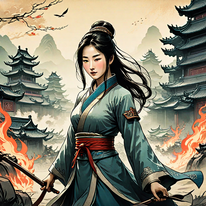
The sky on that day grew dark and cloudy as Yangchen entered Garjin with her army. The people of Garjin were all indoors trying to hide from her seething desire for revenge. The entire city was quiet until Yangchen screamed out loud "Men, burn this city to the ground and leave nothing breathing!". She lit a torch and began burning every house she came across as her men began killing those who were hiding inside. The sky glowed a dark orange as the city burned to ashes, along with the defenders of the city and the Azunga leadership while she watched from a hill away, satisfied with her revenge at the people who brought nothing but death and destruction to her domain. -The Legend of Yangchen, Chapter 21
In a diary recovered from the Talbushek Archives believed to belong to Empress Yangchen, she remarked on the sheer amounts of loot she had captured from the enemy, writing, but may not be accurately translated - "In my unmatched glory, I have captured nearly 200 tons of gold and riches from the enemy, as well as around 10,000 people from all ages and backgrounds that I can now make to do my bidding"[3].It is believed that the captured slaves from Garjin were later used to construct Yangchen's opulent palace, which still stands today in the city of Qana-Qanaqaa.
Empress Yangchen died at the age of 46 in Caldemount in 2954BC, potentially of liver cirrhosis due to her extremely lavish lifestyle, but in the legend, it is stated that Yangchen died after the Gods called her back to Heaven, saying that she had used her Mandate of Heaven well.
Empress Yangchen as the Mother of Gesaria
Due to her status as an extremely revered and worshipped woman, Yangchen's legacy lived on for millennia after her death, with many people believing that her spirit protects the land of Gesaria and Lilytopia, watching over everything that goes on within her domain, and constantly driving away the aforementioned "forces of evil" like disease and invaders. To this day, many people go to her palace in Qana-Qanaqaa to ask for her protection and guidance, with some even asking for their enemies to be cursed by her. Worshippers commonly recite the "Yangchen Ritual" ,which states -
"Those who worship you and recognize you as their divine intercessor, and partner of Gesar and the Heavenly Deities, shall be blessed with fortune and be shielded in your arms. But those who are against you and us who believe, shall be cursed from now to the afterlife" -Ritual of Yangchen [4]
Tribal Era and Bishnu, the Father of Gesaria
After the era of Empress Yangchen and her Kingdom fades away into history, around 2000BC, the land of Gesaria is mostly made up again of nomadic tribes of the Qakhok people, people who are native to the Land of Gesaria and the ancient Kingdom of Yangchen. There were around 6 main tribes: the Choden, Kungar, Ramlek, Azung, Pol-en and Yangin. These tribes were mostly divided amongst each other but lived peacefully for eight hundred years until relationships suddenly broke down between the tribes in 1200BC. It is said that the Azung and Ramlek tribes disagreed on the extent of their domains, leading to a skirmish between them that dragged all the other tribes into the conflict known as the First Sikkim War. Choden and Yangin backed the Ramleks while Kungar and Pol-en backed Azung.
The Ramleks, led by warlord Bishnu Rasmijoti however had vastly superior numbers and technology and easily managed to overwhelm the enemy tribes and force them to surrender after 1 and a half years of fighting. In the negotiations, it was decided that the 6 tribes would unite under Bishnu to form a new unified nation-state, the Kingdom of Bishnu Pradesh.
Bishnu Pradesh would go on to be a prosperous and powerful state and the dominating power in South and Southeast Asia, winning many battles against the other warlords in China, extending his empire from Delhi in the west to the Philippines to the east. In 790BC, the twin warlords of Yuan Shao and Shang Jin invaded Bishnu's territory in Vietnam. Bishnu successfully defeated them at the Battle of Huanjin, forcing the twin warlords to retreat back into China.
It was the dawn of the winter solstice when the two warlords faced Bishnu.They had far superior numbers than Bishnu, and they were confident on their victory. But they were no match for the strong and powerful Bishnu who soundly defeated them. A thousand men couldn't equal to his strength. The two warlords were forced to retreat like cowards, having learned their lesson - "If you dare to attack the man who equals a thousand men, you will bring death and dishonor to yourself and your nation. - Biography of Bishnu by Akar Dhargey, Chapter 10
Legacy
Bishnu would carve up a massive empire and cemented his legacy as one of the greatest military generals in history, far outmatching most generals for his time. He was known for his early use of modern-day tactics like blitzkrieg and exhaustion and attrition in fighting enemies. At the empire's peak, it was estimated that around 5 million people called the empire home, representing 10% of the world population at the time. Bishnu Pradesh was also one of the very few stable and long-lasting nation-states that existed at the time, with Bishnu Pradesh lasting for 600 years.
Bishnu Pradesh is widely known in the country as the official beginning of Gesaria, as Bishnu was born and raised in Khuukh-Uzuur in modern day Gesaria. To this day, Bishnu Rasmijoti is considered as the founder and father of Gesaria , unlike later leaders because they only served to refound Bishnu Pradesh.
Bishnu Rasmijoti died at the age of 64 in 1160BC in Khantuan (modern day Jezero in the Bazzo Province), surrounded by his advisors and soldiers. At his funeral in Khuukh-Uzuur, nearly 15,000 men attended, saluting the man who brought glory and honor to this land. Bishnu's son, Akumu Rasmijoti would inherit the throne from his father, and further solidify Bishnu Pradesh's existence.
Fall of Bishnu Pradesh and the Bhavikian Period
After the era of Bishnu, his descendants would continue on ruling Bishnu Pradesh for 600 years until 600BC, when an incompetent leader name Dujom Garab would rise to the Bishnute throne. Dujom was a weak leader, while his advisors, had grown corrupt with all of the wealth flowing into the empire. As such, the state of Bishnu Pradesh started growing unstable, as many of the tribes that had allied with Bishnu 600 years ago, felt like they were being betrayed. A period of infighting erupted between the tribes, known as the Second Sikkim War, resulting in many of the tribes cutting ties with Garab's government.
Another warlord to the south in Manipur, named Bhavik Agarwal, noticing Bishnu Pradesh's increasing instability, launched an invasion of the empire. The Bishnute army, underequipped and undersupplied due to the weak and corrupt government, were soundly defeated and massacred by Bhavik's army, leading a genocidal campaign of conquest against Bishnu Pradesh. Bhavik soon reached Bishnu Pradesh's capital in Choibalsan, entering the city and burning it to the ground, slaughtering many civilians along the way in a style similar to Yangchen's conquests one thousand years prior. Bhavik's army seized the palace, forcing Khan Dujom Garab to step down from the throne where he was beheaded and displayed in public a few days later. After Bhavik successfully took control of the Bishnute capital, he immediately proclaimed himself the new emperor and officially declared the new Kingdom of Bhavikia and Kozudia (KBK), stemming from his name and the name of his allied warlord, Kozud Gyalwa.
The brutality of Bhavikian rule
In the following years after the foundation of the KBK, the people of the former Bishnu Pradesh were enslaved and oppressed by the new government based in Bhana in Manipur. Atrocities were frequent and the new government ruled the land with an iron fist.
Atrocities
The new government committed many atrocities on the Qakhok and Bishnute people. Many people were forced into slavery to harvest grain and cotton. Children were being kidnapped from their villages and forced to mine coal in the Himalayas, with hardly any clothing in the regularly freezing temperatures. Children unable to meet their quotas often have fingers removed or at their worst, their entire families shot and killed in front of them while being brutally punished for any expression of grief. Women are often abused and forced into unspeakable acts by their masters, as well as being forcefully starved if they do not comply with the orders and desires of the "master race". Most of the strongest and most capable men are forced to do hard labor like lifting bricks to construct massive houses and palaces, forced to work 18 hours a day and fed very little, only around one small bowl of rice every day.
The new government also engages in purposely using famine as a means to control the population from rebellion, often cutting entire villages off from food if even one person acts rebelliously. The people in these villages were so deprived of food that they started cannibalizing each other. Those who were old or young who could not contribute to the village were often devoured. Families were forced into eating their own relatives, and children often saw their grandparents being eaten. Life was terrible, but no one could gather enough support to overthrow this new government.
Death of Bhavik Agarwal
Bhavik Agarwal died at the age of 56, likely because of colon cancer , and the throne was passed on to Kozud Gyalwa, who upon inheriting the throne, immediately abdicated for Bhavik's son, Omar Agarwal, to take the throne. The brutality of the KBK's reign continued long after Bhavik's death, lasting all the way to 100BC until things started to change towards the favor of the oppressed people.
Ram Acharya and the Second Bishnute Empire
After the collapse of Bishnu Pradesh, the tribe of Bishnu, the Ramlek was divided into twelve tribes known as the Twelve Tribes of Bishnu. These are the Kalmuks, Sogbyuls, Xhaksus, Baxzos, Aldines, Sopians, Eevsumig, Gorgyug, Qanaqs, Ilmoks, Derochronids, Chibutallen, and Kahll-Imqq. These tribes were largely fighting with each other at first, but once again in 100BC they united under the rule of a Qakhok Scholar from the Eevsumig tribe named Ram Acharya. Ram was actually born and raised in relative luxury and comfort,born in Talbushek and was sent to an exclusive private school to pursue History. It is said that when his professor started discussing about the Qakhok and the Bishnute tribes, talking about their inferiority to the Bhavikian race, Ram Acharya felt angered and knew that he had to be one to liberate his people from this oppression. After he finished his studies, he returned to the Qakhok homeland of Gesaria (known back then as Yangchenia, but the term is now use today for the land north of Gesaria), and began to gather the tribes to launch a revolution against their conquerors.
The Ram Revolution
Ram gathered an army of 3000 and overthrew the government of their province, successfully seizing the Choibalsan Palace and capturing the governor, whom they forced to give up power. From the balcony of the Palace, Ram Acharya declared the independence of Bishnu Pradesh as a separate and sovereign entity from the KBK. Ram knew that this would almost certainly ignite the wrath of the KBK, and he knew that they would not hesitate to slaughter and massacre his people in an act of genocide. But to him, this was the only way to secure a brighter future for himself and his people.
In a speech he gave to his army, which functioned as the official Declaration of Independence he said:
"We of this generation, and as the descendants of Bishnu and Yangchen, as the future of the Qakhok people, as the light of hope for all people in this region, as the beacon of resistance against tyranny and oppression, as the avengers of the suffering our ancestors endured, and as the people who will carry the torch of our and our ancestors legacy into the future, we have for ourselves a great responsibility. The fate of our people and all people of this region lies with us. If we fail, then our children will never get to see a world of prosperity and freedom. We would likely be wiped off the face of this planet, every man, woman and children here would be systematically killed. We have already made the first move, and now it is our duty to finish this. Even if we lose, it is better for our people to die loud than to fade away. With this, I officially declare the start of a new nation, built on peace and equality for all peoples, blind to race and class. --- Ram Acharya
Ram Acharya's idea of freedom and independence swept throughout KBK. Many slaves began protesting against the government, often refusing to do what their masters had ordered them, despite brutal punishments. These protests soon started devolving into riots as the long oppressed slaves began unleashing all of the bottled up anger that they had stored from all of their mistreatment. The KBK armies originally managed to quell these rebellions, but soon they were overwhelmed and many of the provinces, whose governments had been taken by the rebels, defected to Ram's side. By 90BC, the once large empire of the KBK had dwindled down to only a few towns and villages in Manipur as Ram Acharya claimed a decisive victory and freed many of the people from slavery.
After the fall of the KBK, Ram Acharya officially established the Second Bishnute Empire in its place, built on the idea of equality and freedom, as well the abolition of slavery as a practice. This was the first instance of an Asian nation enacting these policies. It wasn't long until the Second Bishnute Empire grew prosperous and under these new ideals, the people of the Second Bishnute Empire were considered as one of the freest and happiest people in the world at the time.[5]
Ram Acharya continued to rule the empire until 10BC, where he died at the ripe old age of 102. His descendants continued to rule the empire until 250AD, when the Second Bishnute Empire was conquered by the Wei Kingdom (Jin Dynasty).
Chinese Rule
Chinese Dynasties ruled over Bishnu Pradesh for 1010 years, greatly influencing modern-day Gesarian Culture to be more Chinese and Tibetan influenced than Indian influenced. This is also the period where the land of Gesaria fully recovered from the centuries of Bhavikian rule, and also developed many parts of the country, especially in the rural areas. The city of Talbushek, initially a small rural farming and herding village, grew into a major trading village and the sixth largest trading outpost in the Jin Dynasty.
When the Middle Ages occurred, much of the information about the events that happened in this period of Gesarian history was lost time, but what is known is that the Chinese continued to rule over this region until 1271 when the Mongol Empire took over this region and absorbed it into the Yuan Dynasty of China.
Mongol Empire
The Mongols took over the region of Bishnu Pradesh in 1260BC, incorporating it into the Yuan Dynasty eleven years later, with the region falling under the rule of the Khan, Imhran Shan. This period in history is widely considered as the "Golden Age". Living standards improved, infrastructure was developed and the system of leadership was reformed. Qakhok culture thrived once more under the benevolent Khan's reign.
Etymology behind the name "Gesaria"
The Mongols, arriving in Bishnu Pradesh, witnessed a battle between Indian Tribes and the Qakhok Gurkhas near the city of Xhaksu. The Mongols were impressed at the Qakhok Gurkhas's fighting skills, and named the region in honor of them, using the term "Uul-Gyesar" when referring to the region. This name comes from the Epic of King Gesar, a famous Tibetan epic depicting Gesar, a legendary warlord from the Kingdom of Ling . "Uul-Gyesar" is therefore supposed to mean "Mountain of Gesar" or "The Land of the Mountain Warriors",as Gesar was a warrior.
In the current era,the name Uul-Gyesar is interpreted differently,now also meaning "Land of the Mountain Emperors",as the name Gesar itself comes from the word "Kaisar" meaning Emperor.[6]
Independence and the Founding of the Kingdom/Queendom of Gesaria
When the Mongol Empire was divided in 1294, the Khanate of Uul-Gyesar was granted independence as a seperate Khanate under the rule of the newly crowned Queen, Arudshebet "Aisha" Dawa.
Collapse and Recovery
Despite their newly found independence, this quickly proved to be disastrous for Gesaria. Now that they were independent, the financial aid that the Mongols were giving to the country quickly ceased, and the country quickly fell into poverty. Slums spread and crime rates increased. Queen Aisha immediately began creating a plan to revive the kingdom and lift it out of poverty. To solve the instability in the country, Queen Aisha declared martial law. She had her opponents and the leaders of the party against her killed. She imposed a curfew, suspended rights, banned free expression, and legalized the use of torture against prisoners. Despite these brutal measures, it worked in curbing violence which allowed the government to enact their reforms. She encouraged neighboring nations to invest in Gesaria in exchange for her support in any conflicts they were in. With the money she got, she built houses and sold them to people at a low price. She built a system of socialism and all land belonged to the state. People were given land to farm and encouraged to set up businesses. Port usage taxes are lower compared to others. It attracted merchant vessels that came to the port of Gesaria. She allowed foreign businesses to enter the country. She lowered the minimum wage to attract more foreigners. The businesses built in Gesaria all became successful and the amount of tax paid to the government grew. The country became rich and their period of poverty ended. The Queendom of Gesaria had established itself as a large commercial hub for merchants and traders in the region, constantly bringing in essential capital to the country.
Death of Queen Aisha and Modern-Day Gesaria
Queen Aisha died on 8 May 1334 in Caldemount, dying at the same place that her ancestors Yangchen and Ram Acharya chose to die in. She was widely regarded as the "Hero of Gesaria" for her leadership in the development of the country. In honor of her and her legendary ancestors, Caldemount was designated as the national capital of Gesaria, with the cities of Khuukh-Uzuur (birthplace of Bishnu), Talbushek (birthplace of Ram Acharya) and Qana-Qanaqaa(birthplace of Empress Yangchen) serving as cultural capitals of the nation.
[7]After the reign of Queen Aisha were several Kings and Queens of Gesaria (also known as Emperor or Empress sometimes) that ruled Gesaria for the 700 years between then and the modern day. King Drozhin Kungar Liko (commonly referred to as "King Liko") was the first considered King of the modern era, ruling from the 11th of March 1979 after the death of his father, Karim Nevesh II and dying on the 30th of November 2018. King Liko was known to be a wise King, and easily adapted the nation to the constantly evolving world of modern technology. He was also a great military strategist, credited for his outstanding victory over the Indian Empire, defeating a force of 45000 with an army of 5000. When he died in 2018, the throne passed on to his wife, Alexandra of Aezelfjord, but she abdicated the throne after she was taken hostage one day, but still being the de facto leader, with the official leader being her daughter, Selena Dawa. But due to her young age, being 9 as of 2024, a Supreme Leader was elected to serve as a leader and advisor to Queen Alexandra, with Rakesh Gujarati (R.I.P 1976-2019) and Prem Singh being the only ones to serve in the position so far.
Geography and Climate
Regional Geography
Gesaria Region's geography is mostly mountainous, with the nation being located on the southern slopes of the Himalayas in the north of the Indian Province of Sikkim,and is known for hosting the world third tallest mountain, Mount Kanchenjunga. The country also has vast plateaus and valleys nestled between the mountains, which serve as the primary living areas for 90% of Gesaria's population. The massive Himalayas surround the region on it's west and north, with the Sikkim mountain range separating the region from Sikkim,and the Qapanaq mountain range separating Bishnute and Lilytopia from Yangchenia.
Gesarian Geography
Gesaria serves as the passageway between these two regions, and is considered as the most developed and populous of the regions. The snow-covered Limberwisk Basin has the highest average elevation in the Gesaria Region, with an average elevation of 3000m , but is also the least populated with an estimated population of only 1.6 million. Gesaria also hosts the largest urban metro area in the region, Lusamino and Varosha, and 6 out of the top 10 cities in the region are located in the Free Cities(now known as the Free Economic Cities Zone) of Gesaria.
Climate
Gesaria's climate as well as for the whole region is mainly dominated by dry cold seasons and wet monsoons, with the Himalayas pushing most of the rain to pour down on the region, resulting in high levels of rainfall throughout the wet season of June to November.
From December to May, the region experiences the cold season, with the average temperature in the region dropping to 2 degrees Celsius, with the lowest recorded temperature in the region being -45C in Northern Yangchenia.
Gesaria proper has a mostly moderate climate,with it being in the center of the region and not immediately bordering any of the cold mountains of the Tibetan Plateau. The coldest area in Gesaria is still the Limberwisk Region, with an average temperature of 5 degrees Celsius in the summer and -10 in the winter.
Environment
The Gesaria region and Gesaria itself is home to diverse flora and fauna, with massive forests covering much of the region as well as biodiverse marine ecosystems. The mountains of the region are home to many animals like goats and bears that roam the mountains, while the forests are home to many creatures like deers, foxes, and even pandas. The legendary Dragons are also plentiful in the region, with their being 4 species, The Fire Dragon, Ice Dragon, Thunder Dragon, and the Earth Dragon.
The region is also home to several National Parks and Forest Reserves, with the Northern Reserve in Yangchenia being the largest, covering an area the size of Bulgaria. Roughly 35% of the region is part os these National Parks, with half of them being Forests. Due to the region's pristine and untouched nature, great effort has been made to preserve it, notably with the restriction of Industrial Manufacturing. The only industries allowed are industries that are integrated into Gesarian culture, like basket weaving and Trout fishing.
Government
Government Structure
The Government of Gesaria is classified as an Absolute Monarchy. According to the Constitution, every Gesarian citizen shall show absolute obedience to the ruling monarch, to abide by what they declare, to obey their every word. The monarch is the highest position in the government. Gesaria's monarch currently is Princess Selena Dawa of Caldemount. She inherited the throne from her father - the most High King, Liko I. She was only seven when she inherited the throne and nine years old today. Due to her young age,a secondary leader is elected every two years to be the acting ruler of Gesaria.This acting ruler is called the Supreme Leader.
The first Supreme Leader, Rakesh Gujarati, known as the pioneer of Gesarian democracy ,only ruled for one and a half years before according to his political rival, Prem Singh (nicknamed Big Brother due to his 1984 like policies and ministries), Rakesh dying of an unfortunate"window-based accident". Big Brother took the position of Supreme Leader after being personally appointed by the princess herself. Upon claiming the position of Supreme Leader, he immediately banned elections, apart from those electing local officials or the country's National Assembly.
Further down the hierarchy we find the Ministers of each Ministry of Gesaria,they are tasked with overseeing the operations of their respective ministries,each one integral to the operations and the survival of the Gesarian state.
Followed by the Ministers is the National Assembly. This is a group of 1000 members that creates laws for the country to be implemented. Currently, the National Assembly is heavily influenced by Big Brother's Party, GESOC.
SEATS IN NA DIVISION(BY AMOUNT OF SEATS PER PARTY)
GESOC-850 seats
Association of Corporations-100 seats
UNION-50 seats
Theocratic Party-25 seats
W.E.I.R.D.(Western Educated Indusrial Rich and Democratic Party)-25 seats
After the National Assembly are the Local leaders. They oversee the city or village that are assigned to them.
Political Parties
Gesaria's Political Parties serves as the lawmakers of the nation. They serve in the national assembly and are elected by the population, being the only one allowed to be elected other than the LGU.
GESOC
GESOC is a political party founded by Prem Singh(aka Big Brother).GESOC is an abbreviation for Gesarian Socialism. GESOC believes that peace can only be achieved through authoritarian rule and that compliance can only be extracted from the populace through an Iron Fist.
"Peace through Dictatorship" "Compliance through Fear" "Patriotism through Propaganda"
Alliance of Gesarian Corporations
The AGC is a group of companies cooperating with the Movement for Gesarian Capitalism(MGC).They desire to make Gesaria a tax haven to attract foreign businesses and investment in the country.AGC strives to create a free market in Gesaria and open the country to capitalism.
The UNION Federation
The UNION is a political party formed with the merger of five smaller parties - The Communist Party of Gesaria, Neo-Bolshevik Party, Action Party, Movement for Environmentalism, and the Young Mens Christian Association of Gesaria.UNION is led by a woman named Persephone Damchoe, who rules over UNION with an iron fist to keep the alliance together.Even with UNION's authoritarian rule within itself,it promises to restore the Rakeshian system of Democracy and return elections, both of which was banned when GESOC took command.
The Theocratic and Spiritual Party of Gesaria
The TSP is a political party founded by Choden Chöphel,a Bhutanese Monk and the head of the Gesarian Buddhist Religion. TSP promises to return Gesaria to its old ways of a traditional Buddhist Kingdom based on principles of co-existing with nature,its absolute power sitting in the monarchy, and rejecting the advances of capitalism and modernization.
The W.E.I.R.D Party
W.E.I.R.D stands for Western Educated Industrial Rich and Democratic. These are the five missions of the WEIRD party, promising a modern and westernized Gesaria.Here are their 5 missions broken down
Western
The Western Mission strives to integrate Gesaria with the Western World, culturally, economically, and politically.
Educated
Aims to make Gesaria a global leader in scientific advancements and technological breakthroughs.
Industrial
Aims to make Gesaria an industrial powerhouse,a world leader in manufacturing and global industry.
Rich
Aims to make the Gesarian economy powerful and improve the lives of every Gesarian citizen
Democratic
Aims to make Gesaria a bastion of democracy where every citizen has a voice in the government.
Demographics
Population Religion and Ethnicity
According to the 2024 Gesaria Region Census, Gesaria had the largest population in its region, with total citizens of 400,102,100, an increase of 269 million people from the 2014 figure of 131.1 million. It is estimated that most of those new citizens are simply Gesarian Buddhists who recieve automatic citizenship upon converting to the faith. Only including people living in the country (excluding citizens of Bishnute, Lilytopia and Yangchenia) only around 181.6 million people actually live in the country. This is still an increase of 50.6 million people from the 2000 figure of 131 million. It is estimated that 29 million of those people are immigrants, mostly originating from Southeast Asia and Central Asia.
| Country of Origin | Number of Immigrants 2024 | Number of Immigrants in 2000 | Rank in 2000 |
|---|---|---|---|
| India | 6,000,182 | 2,002,302 | 3 |
| China | 5,549,000 | 3,510,000 | 1 |
| Russia | 3,167,122 | 2,060,000 | 2 |
| Nepal | 2,400,102 | 980,000 | 5 |
| Bangladesh | 1,890,000 | 1,200,000 | 4 |
| Myanmar | 1,290,000 | 539,000 | 9 |
| Philippines | 1,110,000 | 938,000 | 6 |
| Palestine | 1,010,000 | 180,000 | 14 |
| Israel | 970,000 | 340,000 | 10 |
| Bulgaria | 960,000 | 890,000 | 7 |
| Syria | 840,000 | 230,000 | 12 |
| Mongolia | 650,000 | 190,000 | 13 |
| Western Europe | 570,000 | 140,000 | 15 |
| Bhutan | 350,000 | 260,000 | 11 |
| Indonesia | 320,000 | 540,000 | 8 |
| Thailand | 240,000 | 123,000 | 16 |
| United States | 92,000 | 7,800 | 17 |
Gesarian Immigrants regularly originate from the neighboring nations of China, Nepal, Bhutan and India as well as nearby nations. Many Gesarians also come from Russia, Bulgaria and Mongolia, as many parts of Gesarian culture have Slavic and Mongolian roots. Israelis and Palestinians also regularly immigrate to Gesaria as they want to escape from the violence going on in the Middle East. Westerners dont often immigrate to Gesaria, with Western Europe as a whole only accounting for 570,000 immigrants, while only 92,000 Americans have immigrated to the country.
| Religion | Number of Followers(2024) | Number of Followers(2000) | Increase |
|---|---|---|---|
| Gesarian Buddhism | 340,190,000 | 150,000,000 | |
| Buddhism | 70,000,000 | 34,020,000 | |
| Hinduism | 50,000,103 | 21,000,012 | |
| Jainism | 24,031,000 | 14,020,000 | |
| Christianity | 16,402,000 | 4,500,021 | |
| Islam | 12,320,000 | 9,020,001 | |
| Confucianism | 9,829,000 | 789,000 | |
| Taoism | 3,400,234 | 350,000 | |
| Judaism | 1,890,000 | 780,000 | |
| Atheism | 760,000 | 1,029,000 |
State Religion (Gesarian Buddhism)
Gesarian Buddhism is similar to Buddhism, it is based on the principles of achieving happiness and satisfaction in life. Gesarian Buddhists believe that life is all about finding happiness within oneself, and that involves removing materialistic desires from oneself, and instead pursue what makes you happy, what gives you peace, and what gives you wisdom and enlightenment. Material things can be destroyed or stolen by others, while no one in the world can steal your wisdom and enlightenment, it is something that is inherently yours. Gesarian Buddhism also teaches that letting people disrupt your state of peace of mind can lead to unhappiness and you should stay away from such people as they are "negatives" in your life that dont interact with you well.
Gesarian Buddhism uniquely teaches about the concept of a ruling deity, a sort of God-like figure that watches over you and other people that were born under that deity. They are called Domains, and there are 4 domains, Domain of Yangchen, Domain of Bishnu, Domain of Gesar, and Domain of Ram. These domains are also paired with a respective elemental Dragon, Fire Dragon(Yangchen), Earth Dragon(Bishnu), Ice Dragon(Gesar), and Thunder Dragon(Ram). Your domain is decided by your birth year, and which deity and dragon rules over that year. This belief in Domains and Dragons has a unique term, (Qik) meaning natural self. The qualities associated with each domain is your natural self, and instead of trying to be someone else, you should just be yourself. You are your natural you, and you should stick with it.
Finally, Gesarian Buddhism teaches about the need of non-conversion. It says that Gesarian Buddhism is not a religion, but more of a way of life, and how to live life. It does not care about life after death, but it cares about life before death, and how you can make the most of it.
| State | Number of People(2024) | Number of People(2000) | Number of People(1900) | Number of People(1600) | Number of People(1260) | Number of People(220) | Number of People(2000BC) |
|---|---|---|---|---|---|---|---|
| Gesaria | 181,060,000 | 131,020,010 | 46,000,202 | 6,050,040 | 4,300,102 | 1,902,000 | 345,000 |
| Lilytopia | 120,000,000 | 78,060,050 | 32,010,002 | 10,202,000 | 3,200,010 | 2,403,300 | 92,000 |
| Bishnute | 56,093,002 | 32,010,002 | 26,019,000 | 2,040,000 | 5,040,000 | 3,020,001 | 260,000 |
| Yangchenia | 34,506,005 | 40,020,001 | 17,899,001 | 11,020,000 | 4,939,000 | 2,030,100 | 547,000 |
Languages
There are as many as 140 living languages in Gesaria alone. The languages most commonly spoken belong to the Sino-Tibetan, which contains Chinese,Tibetan, Dzongkha and Sikkimese; Indo-Aryan,which contains Hindi and Nepali, Mongolic and Indo-European Russian language families.
Qanupaq, specifically the Caldemount dialect is the national language of Gesaria and the most spoken local language in Gesaria. The language is known for featuring words influenced by many different languages, especially Mongolian, Tibetan and Russian, with a tiny bit of English influence as well. This makes the language hard to learn as one must require mastery over several languages to even learn it, especially as the influencing languages belong in different language families.
Education
Education in Gesaria consists of kindergarten, elementary school, and high school, which together lasts for 14 years. It is important to note that public education in the country is notoriously underfunded, with there only being around 500 public schools for a young population of 50.6 million. Due to the current regime led by the political alliance between GESOC and the Juche Party, the government has expressed it's desire to keep the population ignorant and "plain dumb" in order to suppress dissent. The World Education Ministry later stated "For the government, knowledge is dangerous to them." As such, the country is one of the least educated countries, with only 27% of the population being tertiary-level graduates.
For the elite children of the country, their education is usually done by privately hired tutors who give their full attention to one student only or educated in fancy private schools in the country's major cities. The largest university in the country, University of Caldemount is responsible for producing many of the nation's top scientists, engineers and entrepreneurs.
Health
Gesaria, by constitution guarantees free, universal healthcare for all of it's citizens, and is reported to have a pretty well-funded healthcare system. There are roughly 7980 hospitals in the country, with the Ministry of Health overseeing it's operation. The country is also open to private hospitals so that elite citizens can elect to pay more to recieve personalized care and better services. The healthcare industry is also large, with around 2.89 million people employed in the industry.
In 2023, Gesaria spent roughly 14.9% of it's GDP on healthcare, the highest healthcare-related spending in the world. In 2023, the overall life expectancy in the country was 76 years (74 for males and 78 for females). But there is a significant disparity between rich and poor folks, with the poor having a life expectancy of 65 (63 for males, 67 for females) while the rich have a life expectancy of 87 (85 for males,89 for females).
The leading cause of death in Gesaria is cardiovascular disease, with Obesity being a prevalent issue. Old age is the second-leading cause of death in the country, with many people being centenarians or supercentenarians. Murder is also a common cause of death, being the third leading cause of death due to the nation's high crime rate.
Foreign Affairs
Gesaria's foreign affairs is managed by the Ministry of Foreign Affairs, which oversees the construction of embassies, diplomatic exchanges and political summits between Gesaria and foreign nations.
Embassies
Gesaria has an embassy in every single one of the major world alliances, and also has numerous embassies in various countries. The first embassy that was opened between Gesaria and another country was the Bulgarian embassy in 1914, after Gesaria aided Bulgaria after the disastrous invasion during the Second Balkan War. Although Gesaria had a formal alliance with Bulgaria, it did not join the Central Powers during WW1 nor the Axis Powers in WW2. The Soviet Union and Tibet would become the next countries to establish formal relations with Gesaria, with Tibet temporarily pulling out of relations after Chinese occupation of the country. Today, Gesaria operates embassies in 20 countries, with the newest embassy in Athens,Greece being opened on June 10th, 2024 .
| Host Country | Ambassador | Date of Opening | Address |
|---|---|---|---|
| Bulgaria | Boris Vyacheslov | March 14, 1914 | g.k. Yavorov, "Tsar Ivan Asen II" St 1Б, 1124 Sofia, Bulgaria |
| Soviet Union/Russia | Tashi Rasaily | May 19, 1922 | Mokhovaya St, 7, Moskva, Russia, 125009 |
| Republic of Turkey | Sum-en Karlimpong | June 19. 1982 | Doğanbey, Şht. Yaşar Akansel Sk. No:4, 06050 Altındağ/Ankara, Türkiye |
| United Kingdom | Raheed Dundaa | November 17, 1941 | Lupus St, Pimlico, London, UK |
| United States | Sounam Boudyam | July 4, 1932 | 117-2 135th Ave, South Ozone Park, NY 11420, USA |
| Nepal | Ahmad Rashidun | January 17, 1956 | P8HF+5F8, Kathmandu 44600, Nepal |
| Mongolia | Gohar Badrsa | June 8, 1998 | WW9W+3MW, BZD - 14 khoroo, Ulaanbaatar 13335, Mongolia |
| Israel and Palestine | Passang Sunwar | February 29, 1984 | Minzar HaMaronitim 3, Armenian Quarter, Jerusalem/ |
| India | Renuka Lepcha | June 22, 1952 | |
| Bhutan | Dorjee Chaban | August 8, 1958 | |
| France | Gohar Rajaketi | September 18, 2018 | |
| Germany | Sodhen Paksang | October 19, 2007 | |
| Saudi Arabia | Jodhen Suk | September 11, 2001 | |
| Ukraine | Jsangwae Hajri | April 10, 2010 |
Economy
Gesaria has one of the largest economies in the world. As of 2024, the country's nominal GDP sits at 28.8 Trillion Qaks (5.76 Triliion USD). While Gesaria is socialist in paper, it is largely a capitalist economy with private industry representing 70% of the economy while government spending represents 20%. Largely no state-operated industry exists at all in Gesaria, with the only state owned industries being companies owned and operated by the royal family, which technically still classifies it as private industry. The black market is also heavily prevalent in Gesaria, with black market activity generating 3.67 trillion Qaks (735.8 billion USD).
For most of it's history, Gesaria was largely a backwards society with nomadic tribes dominating the region, even up to 1750. The nation was largely poor even as it holds valuable natural resources as the nation never had any advanced technologies nor large industries to exploit it. In the 1850, foreign mining companies signed contracts with the Gesarian monarch at the time, Empress Dorjne-Nalijorma granting them rights to exploit these resources. It didn't take long for the Gesarian State to grow rich, with a nominal GDP of 250 Billion USD by 1870, up from 17 Billion USD in 1800.
But much of the mining activity involved flattening mountains to make harvesting minerals easier, as well the clearing of forests for timber. Even with the Gesarian State's newfound fortune, Empress Dorjne-Nalijorma eventually revoked the foreign companies rights to mine in the country, and issued harsh punishments to those found participating in illegal mining. While this caused a slight dip in the economy initally, it helped in preserving the country's rich nature and environment, with Tourism today being the country's third largest industry, contributing 670 billion USD into the economy.
Industries
References
- ↑ Kungar, Ayuma. "The Azunga War" 12 July 2001. Archived from the original on 17 November 2006. Retrieved 8 January 2024.
- ↑ [1] Hotpot Ai Photo Generator
- ↑ (The Legend of Yangchen, p.190)
- ↑ Chophel ,Choden "On Religious Rites and Buddhist Blessings" from the original on 15 March 2005. Retrieved 14 May 2021
- ↑ These were depicted in the accounts of a Gesarian historian named Dorjen Guneg and the rights to his work are owned by the Caldemount University of History. (The Ram Period)
- ↑ "The Origins of Gesaria". The Ministry of Truth and Information. 17 May 1878.
- ↑ "The Capitals of Gesaria" by Gurung, Alben - 1434. Archived on 12 November 2002. Retrieved 18 March 2021.

